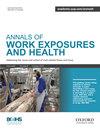63 How to influence worker health protection through effective communication
IF 1.8
4区 医学
Q3 PUBLIC, ENVIRONMENTAL & OCCUPATIONAL HEALTH
引用次数: 0
Abstract
Background A key part of the role of occupational hygienists is about communicating information on health hazards and controls which are needed to protect worker health. How we communicate is evolving in line with the changing world of work, and the increase in remote work. Research shows that email and text-based communication is often overestimated in terms of its influence and impact. According to the research, only 15% of our communication success is due to our technical knowledge, and 85% is due to our skill in communicating, negotiating and leading. Aim This talk outlines why worker health communication can often go wrong or not gain the buy in or support which is required. It will outline new thoughts and new ways of communicating which will win people over to the way you would like them to perceive health hazards, risk and controls. It will enable you to arouse enthusiasm among your work colleagues to want to support occupational hygiene measures. It will also increase your influence and your ability to get things done. Methods This creative and engaging talk demonstrates through factual evidence, historical references, and real-life scenarios where worker health communication has failed and why. It outlines a set of fundamental principles to follow which will revolutionise how worker health protection information is communicated in order to get the best out of people, and positively influence risk perception and behaviours. Outcomes Delegates will learn the fundamental principles when communicating on worker health protection and exponentially increase their influence and success within the workplace and beyond.63 如何通过有效沟通影响工人的健康保护
背景 职业卫生学家的一项重要职责是传播有关健康危害和控制措施的信息,以保护工人的健康。随着工作环境的变化和远程工作的增加,我们的沟通方式也在发生变化。研究表明,电子邮件和文本沟通的影响力和作用往往被高估。研究表明,我们在沟通方面的成功只有 15%归功于我们的技术知识,而 85% 则归功于我们在沟通、谈判和领导方面的技巧。本讲座概述了为什么工人的健康交流经常会出错,或者无法获得所需的认同或支持。它将概述新的思想和新的沟通方式,从而赢得人们对健康危害、风险和控制措施的认同。它还能激发同事的热情,使他们愿意支持职业卫生措施。它还能提高你的影响力和完成工作的能力。方法 本讲座富有创意,引人入胜,通过事实证据、历史参考资料和真实场景,展示了工人健康沟通失败的原因。它概述了一系列应遵循的基本原则,这些原则将彻底改变工人健康保护信息的传播方式,从而使人们获得最佳效果,并对风险认知和行为产生积极影响。成果 学员将学习到工人健康保护沟通的基本原则,并将成倍地提高他们在工作场所内外的影响力和成功率。
本文章由计算机程序翻译,如有差异,请以英文原文为准。
求助全文
约1分钟内获得全文
求助全文
来源期刊

Annals Of Work Exposures and Health
Medicine-Public Health, Environmental and Occupational Health
CiteScore
4.60
自引率
19.20%
发文量
79
期刊介绍:
About the Journal
Annals of Work Exposures and Health is dedicated to presenting advances in exposure science supporting the recognition, quantification, and control of exposures at work, and epidemiological studies on their effects on human health and well-being. A key question we apply to submission is, "Is this paper going to help readers better understand, quantify, and control conditions at work that adversely or positively affect health and well-being?"
We are interested in high quality scientific research addressing:
the quantification of work exposures, including chemical, biological, physical, biomechanical, and psychosocial, and the elements of work organization giving rise to such exposures;
the relationship between these exposures and the acute and chronic health consequences for those exposed and their families and communities;
populations at special risk of work-related exposures including women, under-represented minorities, immigrants, and other vulnerable groups such as temporary, contingent and informal sector workers;
the effectiveness of interventions addressing exposure and risk including production technologies, work process engineering, and personal protective systems;
policies and management approaches to reduce risk and improve health and well-being among workers, their families or communities;
methodologies and mechanisms that underlie the quantification and/or control of exposure and risk.
There is heavy pressure on space in the journal, and the above interests mean that we do not usually publish papers that simply report local conditions without generalizable results. We are also unlikely to publish reports on human health and well-being without information on the work exposure characteristics giving rise to the effects. We particularly welcome contributions from scientists based in, or addressing conditions in, developing economies that fall within the above scope.
 求助内容:
求助内容: 应助结果提醒方式:
应助结果提醒方式:


